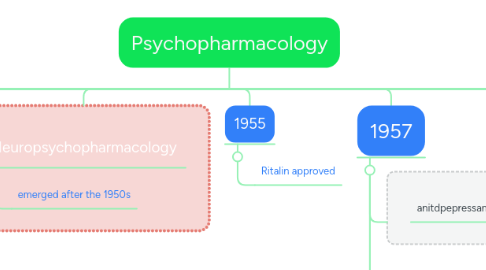Psychopharmacology
by Santek, Michelle


1. 1800
1.1. Oswald Schmiedeberg (1838–1921) is generally recognized as the founder of modern pharmacology
2. 1915
2.1. e behavioral effects of drugs in animals began with the pharmacologist D. Macht
3. 1935
3.1. -Benzedrine. Dr. Charles bradley realized that performance in creased in childen
4. 1948
4.1. Lithium
5. 1950
5.1. first antipsychotic, chlorpromazine, was synthesized
6. 1956
6.1. Fritz Freyhan Pharmacological re-evaluation of psychiatric nosology needed
6.1.1. Fritz Freyhan 1956 Pharmacological re-evaluation of psychiatric nosology needed
7. Neuropsychopharmacology
7.1. emerged after the 1950s
8. 1955
8.1. Ritalin approved
9. 1957
9.1. anitdpepressannts
9.2. Collegium Internationale Neuro-Psychopharmacologicum (CINP)
9.2.1. 1990's
9.2.1.1. 1990s, the college extended its activities by organizing other meetings, including president’s workshops, regional meetings, educational seminars and other programs
9.2.2. 29th centry
9.2.2.1. end of the 20th century CINP was a legal entity that was registered in Switzerland with domicile in Zurich.
9.2.3. 21st cenrty
9.2.3.1. early years of the 21st century CINP established a central office and a congress-organizing group.
9.3. ovet (29) received the Nobel Prize for physiology and medicine in 1957 for his work on synthetic curare-like drugs and aryloxyethylamines as antihistamines
10. In 1964, the
10.1. medicinal chemist, Biel (58), summarized the chemical rationale for developing MAO inhibitors and tricyclic antidepressants.
11. 1966-1968
11.1. PHARMACOLOGICAL HETEROGENEITY WITHIN DIAGNOSES
11.1.1. Precluded the generation of information about pathophysiology of mental disorders
11.1.2. Delayed acceptance of psychotropic drugs for clinical use
